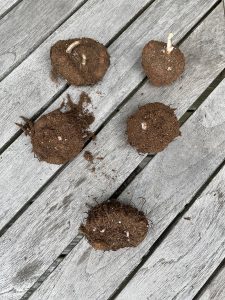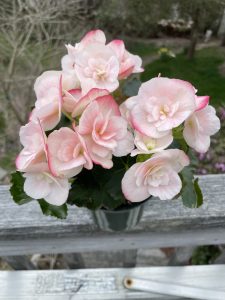Owning a greenhouse allows you to get an early start to growing your own flowering plants for hanging baskets and patio pots that can be set outdoors in summer. Among your choices are begonias. They come in a wide range of colors, thrive in warm weather, don’t require a great deal of water, have a long blooming season, and include varieties that are quite shade tolerant. There are many different kinds of begonias, however. The ones we’re focusing on are the tuberous begonias, which have some of the most striking flowers in the genus. Being native to tropical and subtropical regions, tuberous begonias cannot survive frost. But the tubers can be stored indoors during winter, providing new plants year after year. Today, tuberous begonias include many hybrids, some of which have huge, showy flowers.

Begonia tubers can be easily purchased online or in garden centers, especially as spring arrives. If you already have begonia tubers that you’ve been storing over the winter, very early spring is the time to inspect them. If they’ve been stored properly in a cool, dry place, the tubers will show signs of new growth. To promote this growth, you should move the tubers into pots and put them in a warmer location such as your greenhouse.
Tuberous begonias prefer a slightly acidic potting mix. Some growers use a mix of 50% peat moss and 50% potting soil, while others use coir (more alkaline) combined with both fresh potting soil and perlite. According to the American Begonia Society, you should allow at least 2 inches (50 mm) between the tuber and the pot sides for best growth. Select your pot based on tuber size rather than using the same size pot for all tubers. If roots grow against the edge of the pot, you may want to repot your plants to enable more growth.
Watering correctly is very important to good results. The American Begonia Society says that some growers soak their tubers in water or a sterilizing solution before potting them, which helps initiate growth. Once potted, the tubers are then placed on a heat mat set at 70 to 75°F and are watered in carefully. Begonias should never be overwatered, so make sure your potting mix is damp but not excessively wet. The tubers will rot if overwatered.
As your plants grow, larger varieties with a mounded form can be staked to keep big flowerheads upright. But be careful not to stab the tuber when staking the plant. Also, be patient. It can take a month or more for plants with large blossoms to come into flower. Once they are in flower, though, the beautiful blooms will last a long time. Pinching off some of the stems of a large tuberous begonia can help to encourage bigger flowers on the remaining stems.

Cascading begonias generally have smaller flowers and are excellent for hanging baskets. The display is not in flower size but in a profusion of flowers. Where I am near the ocean, relatively strong winds can quickly dry out the basket soil. To remedy this problem, I usually add hydrogel granules to the potting mix, which absorb moisture when watered and release it slowly over time. This avoids having to water the hanging baskets every day. Hydrogel granules are produced by a number of manufacturers and are available both online and at garden centers.
Another thing to know about tuberous begonias is that they are quite heavy feeders, so your pots or hanging baskets will need to be fertilized regularly. When the tuber is first sprouting, use a fertilizer with a little more nitrogen, such as a ratio of 10-5-5. But as the flower buds develop, change the ratio to 5-10-5 or 5-10-10 to promote blossoming and root growth. Keeping the soil damp with fresh water between fertilizing will help to rinse fertilizer salts from the mix. If all goes well, you’ll be rewarded with the vibrant and colorful show of flowers for which tuberous begonias are prized.
At the end of the summer, you can move your begonias back into the greenhouse to prolong the flowering season. I often find that the flowers last until mid-November in the greenhouse. When flowerheads die back, remove the tubers from the mix and put them in a cool dry spot for winter.










